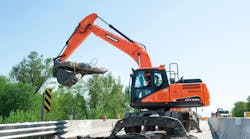Piloting a fighter jet, removing a brain tumor, programing a particle accelerator, and operting a hydraulic excavator all require a high level of skill. Quick thinking, eye-hand coordination, and planning for the next move are all required for safe execution.
When it comes to heavy equipment operation, excavator operators are in their own league. The machine itself is very dynamic, and the work being performed isn't directly underneath the operator as it with bulldozers and motor graders. It can be anywhere within the boom's reach and sometimes the work being performed is underwater.
In the deadline-driven world that contractors live in, the excavator operator is expected to contribute to increased productivity, minimal or no rework, and accurate results. To safely deliver both higher production and increased accuracy, contractors are looking to technology for answers.
GPS Excavator ControlNewer, more sophisticated excavators are being produced by heavy equipment manufacturers. Of keen interest to many earthmoving contractors is the use of GPS-based grade control systems.
The question being asked is: Can a GPS-equipped hydraulic excavator achieve the same productivity increases seen with 3-D blade control on graders and dozers?
Let's start with some fundamentals. How does GPS enhance excavator operation?
GPS-based grade control on excavators provides the exact position and orientation of the bucket to achieve grade faster without stakes.
With accurate 3-D positioning of the bucket, the system guides the operator to quickly perform mass excavation without the fear of over-excavating or to complete complex project designs involving slopes or engineered foundations. Operators can spend more time being productive and less time waiting for surveying and grade checking. Personnel and machine costs are reduced. Material usage, fuel costs and site delays can be minimized.
Applications that can benefit from using GPS on excavators include:
- Mass Excavation — including roads and highways, dams and land reclamation
- Grading — including subdivisions, roads and commercial site prep
- Trenching — ditches and finished slope work for underground utilities
- Dredging and waterways — including breakwater and seawall construction
"GPS systems for excavator give operators the site plans at their fingertips," states Arthur Taylor, Trimble segment manager for machine control. "The system displays for operators where they are on the site, what the desired depth is, and how far from target depth they are — which greatly improves speed to desired depth and prevents over-excavation."
GPS excavator systems have in-cab operator displays that are designed to be intuitive and simple to use, maximizing operator productivity and allowing even those who claim to be 'technology challenged' to be more productive and proficient in a short period of time.
Connected SiteIn addition to the benefits that come from using GPS on excavators, additional time and cost savings can be achieved through the wireless transfer of design files between the office and the excavator. There are connected jobsite solutions software packages available that are designed to not only save time and money — thanks to reduced travel time between the job site and head office — but also minimize rework and errors that can result from excavator operators working with the wrong design file. It is worth your time and effort to look into these systems. Fuel costs being what they are, fuel saved by minimizing travel to and from the job site can be just another step in your fuel management program.
Improved SafetyWith GPS, jobsite safety is improved — especially with trenching applications. "Using a GPS system on an excavator greatly improves trenching safety, because the operator can rely on the on-board computer and light bars to achieve grade without a grade checker entering the trench," Taylor said. "Before the advent of 3-D GPS systems for excavators, grading required the placement of wooden stakes marked with cut and fill information indicating where material was to be excavated to achieve the design grade. After initial machine passes, the grade checker would then remove the stakes or add additional stakes with new cut or fill information."
Taylor continued, "Machine operators often had to guess the proper grade in between the stakes or had to exit the machine to visually check the correct grade against the cut or fill information on the stakes. This process required extensive manual labor to set and move the stakes and rarely achieved the finished grade accuracy now possible using GPS technology. Additionally, the manual staking method required workers to be in the excavation, directly in the work path of the excavator, which slowed cycle times and raised safety concerns for stakers, grade checkers and machine operators."
Additionally, the operator can use the in-cab display of site designs to see potentially unsafe areas to be avoided. With the system providing real-time on-screen prompts and audible tones to indicate hazards such as existing underground utilities, a GPS capability for excavators offers additional safety advantages.
Greater Marketplace AcceptanceThe construction industry is moving toward the general application of 3-D machine control, whether by using GPS or total station-based technology. Recently in the North American market, the adoption rate for GPS in the hydraulic excavator segment has been increasing as well. This increase is driven by three key factors:
- Significant improvements in the products offered for excavators.
- Introduction of GLONASS and modernized GPS signals into construction receivers means machines can be used for mass excavation and bulk earthmoving in more obstructed areas and in deep cuts.
- Market awareness that the same (or better) return on investment can be found in excavators as with other finished grade machines such as dozers and graders.
Taylor adds to that list the increasing availability of new excavators shipped from the manufacturer that are fully prepped for accepting the technology. He cites Trimble's "Trimble Ready™ program," where all base-level install components such as mounting brackets are installed prior to delivery to the end customer. Therefore, no additional welding, drilling or re-painting is required. The primary components of the GPS system can then be simply installed, making the system look and function as if it had been factory installed.
Skilled Operator BenefitsIt is a given that operating a hydraulic excavator requires tremendous skill. "With 3-D GPS excavator control, the skilled operator can really excel," Taylor states.
The future is bright, and hydraulic excavators with 3-D GPS control will definitely be there.
| Author Information |
| Jeff Winke is a construction writer based in Milwaukee, WI. |




